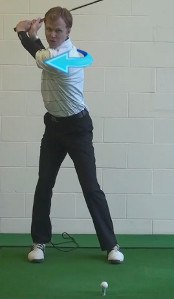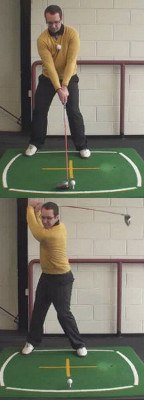
What do you do when you need (or just want) a little extra yardage off the tee?
If you said, “Swing harder” or “Swing longer,” you're in the majority. If you've found that this often produces a wayward shot that may or not deliver the desired distance, your experience is also in the norm.
Swinging harder or longer usually means swinging the arms harder or longer, which only throws your timing out of whack and leads to poor contact. In other words, it's counterproductive. Instead, focus on making a fuller backswing turn and unleashing the added coil into the ball. Here's how:
- Take a few light practice swings, turning the shoulders a touch farther than usual to stretch the back muscles.
- Emulate this motion during your actual swing, making sure to stop your arms and shoulders at the same instant.
Starting down with the left side of your lower body, hold the upper body in place for a split-second before pulling down toward the ball. This will create additional tension between the hips and shoulders, which will be released as you uncoil.
For many golfers, adding driving distance seems like an impossible goal.

It is easy to 'plateau' with regard to your driving distance, even as the rest of your game improves. Once you move beyond the beginning stages of your golf experience, you will likely settle into some swing mechanics, and those won't change much moving forward. You will get better and better at executing those mechanics, and your scores will hopefully improve, but the distances you reach off the tee may not grow.
So, are you destined to be stuck at your current driving distance threshold? Not necessarily. If you are willing to rethink the way you swing the driver currently, you might be able to make some simple changes that can add power to your average drive. In this article, we are going to talk about making an adjustment to your driver swing in the hopes of tacking at least a few extra yards onto the end of your tee shots. You shouldn't expect immediate improvement when you make our recommended changes, but this doesn't have to be a lengthy process, either. With plenty of focus and some quality time spend on the driving range, longer drives may be yours in the near future.
It is important to note that we are not suggesting massive changes to your golf swing technique. Those kinds of changes would take a long period of time to adopt, and you might not even be happy with the results when all is said and done. For the average amateur golfer – with limited time available to practice – it just isn't worth it to rebuild the golf swing from the ground up. So, instead of going that direction, we are going to suggest that you make some subtle changes to your driver swing which may boost your power. Are you going to add 100 yards to your drives? No, probably not – but that's okay. Even adding a few yards can do wonders for your game, especially if you are able to control those longer drives nicely.
All of the content below was written from the perspective of a right-handed golfer. If you happen to play left-handed, please take a moment to reverse the directions as necessary.
Checking on Existing Fundamentals

The purpose of this article is to help you add driving distance by making a couple of important adjustments. However, before we get to that point, we need to make sure that your current fundamentals aren't too far off track. If you are making big mistakes in other parts of your swing, you'll want to address those issues before you work on any of the ideas presented later in the article.
The list below highlights the fundamentals that you should check on with regard to your current swing.
- Knees flexed throughout the swing. Your lower body is one of the biggest power sources in your golf swing. However, you aren't going to be able to tap into the power that is available from your lower body unless your knees are flexed properly. So, for starters, make sure you are flexing your knees a comfortable amount as you stand over the ball at address. Then, once the swing begins, make sure you maintain your knees flex from start to finish. You don't want to be moving up and down during your swing, but that is exactly what will happen if you give up your knee flex before the swing is complete.
- Square stance. It is hard to live up to your distance potential if you are not in a square position at address. Do your best to set your feet parallel to the target line when you settle into your stance. Along with your feet, you also want to make sure that your hips, shoulders, and knees are also squared up. Everything needs to work together so you are free to put all of your available energy into the back of the ball at impact. Not only is a square stance a great way to generate plenty of power, but it should also help you be more accurate.
- Arms hanging freely. You need to make a free and loose arm swing if you really want to maximize your distance. Since your arms are the connection between the rest of your body and the club itself, it is important that they swing as effectively and efficiently as possible. Unfortunately, many golfers get into an awkward position over the ball which forces them to reach out at address – causing the arms to be tense and tight. That is not the kind of position that will promote a powerful swing. To make sure your arms are relaxed, let them hang freely from your shoulders as you stand over the ball. Bend out from your hips slightly to tilt your upper body out toward the ball, and you should be able to let your arms hang down into a perfect position. It may take some practice to find this position time after time, but it will quickly become natural.
It is always a good idea to revisit your swing fundamentals to make sure no improvements can be made. Even if you have done well on certain fundamental points in the past, you can't just assume that those points will remain in good condition for the long run. The golf swing can change over time, even if you don't intend to make any changes. Take a little time during your next practice session to review your fundamentals and make any adjustments that you believe to be necessary.
Two Main Changes

At this point, we are going to move on to the two changes that we are going to discuss in this article. Specifically, those changes are making a fuller turn with your upper body going back, and then slowing down the unwinding of your upper body during the downswing. By the end of this section, you should have a clear understanding of how these two changes can combine to help you hit better drives.
Let's take a look at these points one at a time.
- Fuller turn going back. You may already know that your shoulder turn is related to the power you can create in your golf swing. When you turn away from the ball, you are basically building up the potential for power on the way down. Every inch that you turn back is another inch you can use to accelerate the club head during the downswing. It's not that there is anything inherently wrong with a short backswing; it's just that a short backswing doesn't provide you with enough room to accelerate the club before impact arrives. To add distance to your drives, work on making a bigger shoulder turn away from the ball. Of course, it is important that you don't sacrifice balance while working on a bigger turn. You need to stay balanced at all times during the swing, so the goal should be to turn as far back as possible without running into balance issues. Remember, we are talking about rotation here, so don't try to make a longer backswing by sliding away from the ball. You want to keep your weight mostly over the middle of your stance as your shoulders rotate away from the target.
- Slow unwind of the upper body. This is where things get a bit confusing for amateur golfers. You are probably thinking that you should be unwinding your upper body as fast as possible if you want to hit long drives. And, to a certain extent, that is true. However, if you rush the act of unwinding toward the target, you are going to miss out on a great opportunity to develop speed. The thing to remember here is that creating power in your golf swing is a job for your whole body, not just your arms and torso. Specifically, you want to use your lower body effectively in the downswing to add significant power to the overall swing. Unfortunately, the lower body can only get involved if you give it time to do so. If you rush down and unwind your upper body as soon as the backswing is finished, the lower body simply won't have a chance to do its job. The idea here is to basically hold back on unwinding your upper body until your lower body has had a chance to turn toward the target. You want to give your legs a head start, and then let your upper body turn back through the shot. Working in this order can produce tremendous power, and it can actually make it easier to deliver the club on the proper path.
It is important to understand that you are not going to turn your upper body slowly all the way through the downswing. Instead, you are just going to hold it back at the top for a moment, before letting it go with all of your power. You need to turn your upper body quickly through the ball to hit long drives. However, you can't use that turn too early, or your lower body is going to get left out.
Have you ever wondered how professional golfers are able to make their swings look so easy, despite the fact that they are moving the club through the ball at an incredibly high rate of speed? It all comes down to sequencing. Since professional golfers know how to use their lower body and upper body in the right order during the downswing, they don't have to knock themselves off balance in search for power. They can simply let the club accelerate naturally all the way through the downswing, using both their lower and upper half to get the job done. It is a beautiful thing when it comes together properly, but learning how to put it all together can take plenty of time and practice.
We want to make a point of saying that this is not a tip which only applies to the driver. We are talking about it here in the context of hitting longer drives, but this is actually a technique which should be used with every club in the bag. Whether you are hitting a driver or a pitching wedge, you want to allow your lower body to lead the way. This is a great way to improve your ball striking overall, and you should gain some power at the same time. Also, for players who struggle with the slice, learning how to lead with the lower body is a great way to get out of that frustrating pattern.





